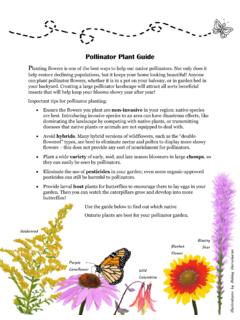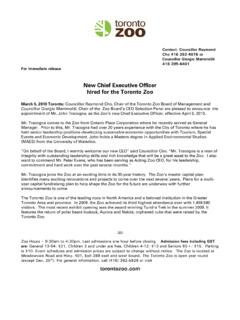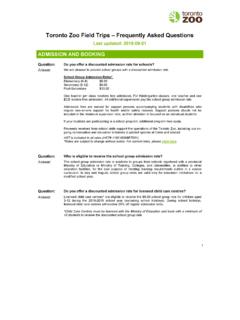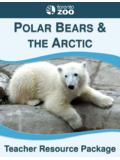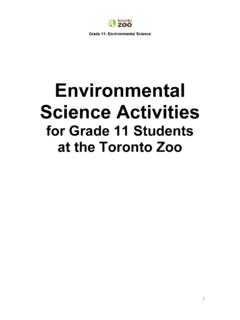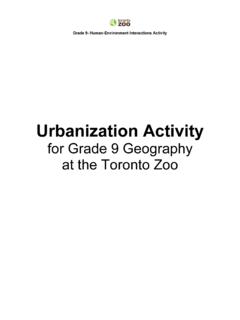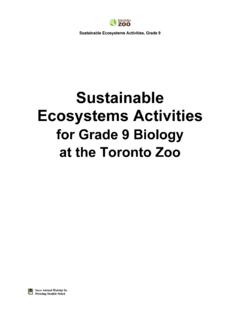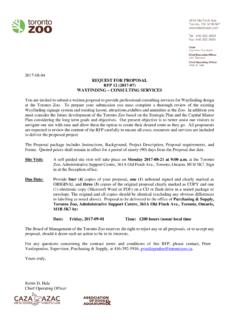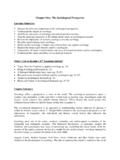Transcription of for Grade 11 University at the Toronto Zoo
1 Grade 11- Biodiversity 1 Biodiversity for Grade 11 University at the Toronto Zoo Grade 11- Biodiversity 2 TABLE OF CONTENTS Pre-Zoo Activities 3 Curriculum Connection 3 Homework Activity The Origin of New Species 4-6 o Answer Sheet 7 Activity 1 Jigsaw on Animal Classes 8-15 Activity 2 Classification Chart Puzzle 16-18 Activity 3 Student Dichotomous Key 19-20 Toronto Zoo Activities 21 Curriculum Connection 21 Activity 1 Adaptations 21-29 o Exemplar 30 o Assessment Rubric (for Activity 1 & 2) 37 Activity 2 Getting to the Nitty Gritty 31-34 o Exemplar 35-36 o Assessment Rubric (for Activity 1 & 2) 37 Post-Zoo Activities 38 Curriculum Connection 38 Activity 1 Vertebrate / Invertebrate Classes Dichotomous Key 39-40 o Exemplar 41 Activity 2 Endangered Animals of Ontario Study 42 References 43 Biodiversity Activity Package Evaluation 44 Grade 11- Biodiversity 3 PRE-ZOO ACTIVITY These activities are designed to prepare your students for the zoo activity.
2 They should take about 35 minutes each to complete. Purpose: To provide students with the basic knowledge of classification systems and adaptational diversity, so they can be well prepared for the zoo activity. Curriculum Connection: By the end of these activities, students will: Define the fundamental principles of taxonomy and explain how species are categorized and named according to structure and/or evolutionary history. Describe selected anatomical and physiological characteristics representative of the animal kingdom. Explain the importance of sexual reproduction to variability within a population Note: Due to the complexity of these expectations, 3 different activities have been suggested for your students. Each activity covers an important component of the expectations.
3 It is advised that you pick the one that is most necessary for your class. Or, if time provides, utilize them in succession. It is imperative that the students have a good knowledge of all these fundamentals for the zoo activities. Before the trip, it is strongly encouraged that all students participate in the pre-zoo homework activity designed to familiarize the students with the zoo and the concepts they will be studying (see below). Any page numbers written beside a sentence correlates with information provided in Nelson Biology 11 Pre-Zoo Homework Activity Objective: This is a question/answer activity based on concepts in regards to adaptation, biodiversity and zoogeography. It is an opportunity for the students to gain some familiarity into the concepts they will be focussing on at the zoo.
4 The teacher should hand out this activity before the actual zoo trip and expect that the students complete the questionnaire for homework. It should be handed in no later than the morning of the trip. See appendices for the assignment and answer key (pgs 6-7). Grade 11- Biodiversity 4 Before your trip to the zoo, take a look at this! Directions: Read article and answer questions. The Origin of New Species The biochemical similarity of all living species indicates that life on Earth probably originated only once, about billion years ago. From one original species came the millions of species found on Earth today. The process of new species formation, known as speciation, is continuing today and will most likely continue in the future. The process whereby one original species evolved into new, distinct species was first described by Charles Darwin and Alfred Russel Wallace more than 100 years ago.
5 This theory of the origin of new species is widely accepted today in the scientific community. Darwin provided abundant and convincing evidence for his theory in his classic book, On the Origin of Species (1859). The wealth of new information provided by the fossil record and by modern molecular biology research has continued to support his theory. The theory of evolution is both simple and elegant. Imagine a population of species of mountain rabbits, living in Canada. Individuals in the population tend to produce more offspring than can survive in that place. Most offspring will die before reaching maturity. In the population of rabbits, one pair of rabbits will produce numerous litters of six or more babies, yet on average, in a stable population, only two of those offspring will survive.
6 Individuals in the population show variations in certain characteristics, and some of these characteristics are inherited, meaning that they are passed genetically from parent to child. These genetic variations are caused by spontaneous changes in the chromosomes and by the rearrangement of chromosomes during sexual reproduction. Within the rabbit population, some individuals have thicker fur than others because of genetic differences. These differences in genetic characteristics will enable some individuals to grow, survive, and reproduce better than other individuals, an idea that is often referred to as survival of the fittest. Our pretend thick- furred rabbits will be more likely to survive cold winters than rabbits with thinner fur. As a result of the improved survival ability provided by a certain genetic characteristic, the individuals with that characteristic will be more likely to produce offspring than the others; over time, the genetic composition of the population will change.
7 After a series of cold winters, more thick-furred rabbits will have survived and produced thick-furred offspring while more thin-furred rabbits will have died. In the process of evolution, populations are constantly adapting to changes in their environment. These changes may be biological (new food, new competitors, new prey) as well as environmental (changes in climate, water availability, soil characteristics). When a population has undergone so much genetic change that is no longer able to interbreed with the original species from which it was derived, the population can be considered to be a new species; this process whereby one species is gradually transformed to another species is termed phyletic evolution. The history of the evolution of a species is called phylogeny.
8 In order for two or more new species to evolve from one original ancestor, there usually has to be a geographical barrier that prevents the movement of individuals between the various populations of a species. For terrestrial species, these barriers may be rivers, mountain ranges, or oceans that the species cannot readily cross. Speciation is particularly rapid on islands. Island groups such as the Galapagos and the Hawaiian Islands have many examples of insect and plant groups that were originally local Grade 11- Biodiversity 5populations of a single invading species. These local populations adapted genetically to the environment of particular unoccupied islands, mountains, and isolated valleys, and have diverged sufficiently from the original species to now be considered separate species.
9 This process of local adaptation and subsequent speciation is known as adaptive radiation. One of the best-known examples of adaptive radiation is that of the Hawaiian honeycreepers, a group of specialized bird species that apparently derives from a single pair of birds that arrived by chance in the Hawaiian Islands tens of thousands of years ago. Even though new species are arising all the time, the present rate of species extinction is probably more than 1000 times faster than the rate of speciation. The situation is actually worse than this grim statistic suggests. First, the rate of speciation may actually be slowing down because so much of the Earth s surface has been taken over for human use and no longer supports evolving biological communities. There are now fewer populations of each species and thus fewer opportunities for evolution.
10 Many of the existing protected areas and national parks may be too small in area to allow the process of speciation to occur. Second, many of the species threatened with extinction are the sole remaining representatives of their genus of family. The extinction of these taxonomically unique species representing ancient lineages is not balanced by the origin of new species. Biodiversity stands for the diversity of living things, and every time a species becomes extinct its genetic material is lost causing a decrease in our earth s biodiversity. Cited From - Primack, R. 1993. Essentials of Conservation Biology, Sinnauer Associates Inc., Massachusetts Grade 11- Biodiversity 6 Answer the following questions based on the previous article 1. Who was Charles Darwin?

